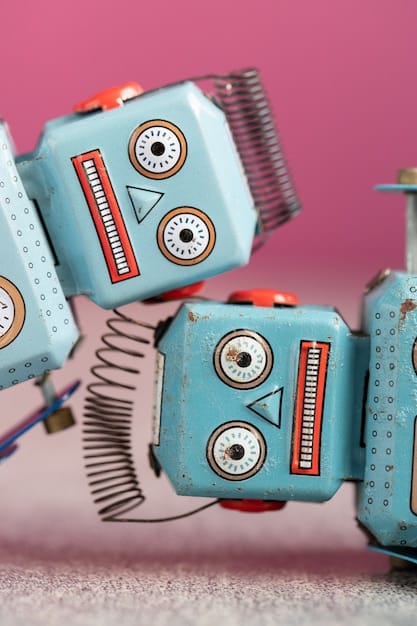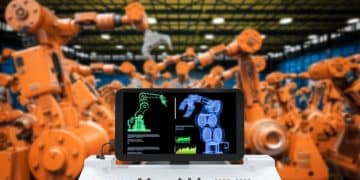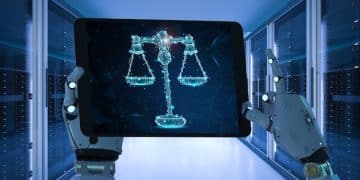The Ultimate Guide to Understanding Artificial Intelligence

Artificial Intelligence (AI) is transforming industries, automating tasks, and driving innovation, encompassing machine learning to create intelligent systems that mimic human cognitive functions.
Artificial Intelligence has rapidly evolved from science fiction to a tangible reality, reshaping how we live and work. Grasping the core concepts of AI is crucial in today’s tech-driven world, particularly as it permeates various sectors, from healthcare to finance. This guide will empower you to navigate the complexities of artificial intelligence.
What is Artificial Intelligence? (AI Definition)
Artificial Intelligence, at its core, is the simulation of human intelligence processes by computer systems. It involves the creation of machines that can perform tasks that typically require human intelligence, such as learning, problem-solving, and decision-making. AI is not a monolithic entity but a broad field encompassing numerous approaches and technologies.
Types of AI
AI can be categorized based on its capabilities and functionality. These classifications help to understand the scope and limits of different AI systems:
- Reactive Machines: These are the most basic types of AI. They respond to identical situations in the same way every time, without any memory of past experiences. A classic example is Deep Blue, the chess-playing supercomputer that defeated Garry Kasparov.
- Limited Memory AI: These systems use past data to inform future decisions. They incorporate memory to learn from experiences, which helps them adapt to changing environments. Self-driving cars, which use sensor data to understand and navigate their surroundings, are a prime instance.
- Theory of Mind AI: This advanced type of AI, still largely theoretical, possesses the ability to understand and predict the actions and intentions of others. It would be able to grasp human emotions, beliefs, and thoughts, which is crucial for complex social interactions.
- Self-Aware AI: The most advanced and currently hypothetical type of AI, self-aware AI would possess its own consciousness and self-awareness. It would understand its internal states and be capable of independent thought and decision-making, raising ethical and philosophical questions.
In summary, AI is the creation of machines with human-like intelligence, divided into varying types based on their learning and cognitive abilities.
The History and Evolution of AI
The journey of Artificial Intelligence spans several decades, marked by periods of excitement, setbacks, and remarkable progress. Beginning as a theoretical concept, AI has evolved into a practical technology that is reshaping industries and daily life. Recognizing the historical context is essential to appreciate the current state and future potential of AI.
Early Pioneers and the Dartmouth Workshop
The formal history of AI is often traced back to the Dartmouth Workshop in 1956, organized by John McCarthy, Marvin Minsky, Nathaniel Rochester, and Claude Shannon. This event brought together leading researchers who laid the foundation for AI as a distinct field of study.
During this workshop, key concepts such as symbolic reasoning and the creation of machines that could learn and solve problems were discussed, igniting the initial wave of AI research. The optimism of this era led to confident predictions that truly intelligent machines were just around the corner.

AI Winters and Resurgences
Despite the initial enthusiasm, AI faced significant challenges in the following decades. The term “AI winter” refers to periods where funding and interest in AI research waned due to unfulfilled promises and technological limitations.
One notable AI winter occurred in the 1970s, when the high expectations of early AI systems were not met, leading to reduced government and corporate funding. Another AI winter followed in the late 1980s and early 1990s, as expert systems, an early form of AI, failed to deliver on their potential.
However, AI has experienced several resurgences driven by advancements in computing power, data availability, and algorithmic techniques. The development of machine learning, particularly deep learning, has led to breakthroughs in areas such as image recognition, natural language processing, and robotics. These advancements have rejuvenated interest and investment in AI, making it a central focus of technological innovation today.
The evolution of AI has been a cyclical process of hyped expectations followed by periods of disappointment, leading to innovation and ultimately progress.
Key Concepts in Modern AI
Modern Artificial Intelligence relies on several core concepts and techniques that are pivotal to its functionality. Understanding these foundational elements is crucial for grasping how AI systems operate and their potential applications.
Machine Learning (ML)
Machine Learning involves the development of algorithms that enable computers to learn from data without being explicitly programmed. ML algorithms can identify patterns, make predictions, and improve their performance over time as they are exposed to more data.
There are several types of machine learning:
- Supervised Learning: The algorithm learns from labeled data, where the correct output is provided.
- Unsupervised Learning: The algorithm learns from unlabeled data, identifying hidden patterns and structures.
- Reinforcement Learning: The algorithm learns by trial and error, receiving feedback in the form of rewards or penalties.
Deep Learning
Deep Learning is a subset of machine learning that uses artificial neural networks with multiple layers (hence “deep”) to analyze data. These neural networks are inspired by the structure and function of the human brain.
Deep learning has achieved remarkable success in areas such as image and speech recognition. The ability of deep learning models to automatically learn hierarchical representations of data has made them indispensable in modern AI.
Natural Language Processing (NLP)
Natural Language Processing focuses on enabling computers to understand, interpret, and generate human language. NLP is used in applications such as:
- Chatbots: Programs designed to simulate conversations with human users.
- Machine Translation: Automatically translating text or speech from one language to another.
- Sentiment Analysis: Determining the emotional tone or attitude expressed in a piece of text.
In essence, the concepts behind modern AI, such as Machine Learning, Deep Learning, and Natural Language Processing, are at the core of AI operations and potential applications.
Applications of AI Across Industries
Artificial Intelligence is no longer confined to research labs; it is transforming industries worldwide. AI applications are diverse and impactful, from automating mundane tasks to enabling groundbreaking discoveries.
Healthcare
AI is revolutionizing healthcare through applications such as:
Diagnosis: AI algorithms can analyze medical images and patient data to assist in the early and accurate diagnosis of diseases, such as cancer.
Drug Discovery: AI accelerates the process of identifying and developing new drugs by analyzing vast amounts of data and predicting the efficacy of potential treatments.
Personalized Medicine: AI enables personalized treatment plans based on an individual’s genetic information, lifestyle, and medical history.
Finance
In the financial sector, AI is used for:
Fraud Detection: AI algorithms can identify fraudulent transactions in real-time by analyzing patterns and anomalies in financial data.
Algorithmic Trading: AI powers high-frequency trading systems that execute trades automatically based on predefined rules and market conditions.
Risk Management: AI helps financial institutions assess and manage risk by analyzing large datasets and predicting potential losses.

Automotive
AI is at the heart of the autonomous vehicle revolution. Self-driving cars use AI for:
- Navigation: AI algorithms process sensor data to navigate roads, detect obstacles, and make driving decisions.
- Safety: AI enhances safety by detecting and responding to potential hazards, such as pedestrians and other vehicles.
- Efficiency: AI optimizes driving behavior to improve fuel efficiency and reduce congestion.
In conclusion, AI applications span across different industries and areas, greatly altering operations and enabling new opportunities.
The Ethical Considerations of AI
As Artificial Intelligence becomes more prevalent, ethical considerations surrounding its development and deployment are increasingly significant. Addressing these ethical concerns is crucial to ensure that AI benefits society as a whole.
Bias and Fairness
AI algorithms can perpetuate and amplify biases present in the data they are trained on. This can result in unfair or discriminatory outcomes, particularly in areas such as:
- Hiring: AI-powered recruitment tools may discriminate against certain demographic groups based on biased training data.
- Criminal Justice: Predictive policing algorithms may disproportionately target certain communities.
- Loan Approvals: AI systems may deny loans to individuals based on biased credit scoring models.
Ensuring fairness in AI requires careful attention to data collection, algorithm design, and ongoing monitoring to detect and mitigate bias.
Privacy and Surveillance
AI relies on vast amounts of data, raising concerns about privacy and surveillance. AI systems can collect, analyze, and infer sensitive information about individuals, potentially leading to:
- Loss of Anonymity: AI can de-anonymize datasets, revealing the identities of individuals who believed their data was protected.
- Surveillance States: AI-powered surveillance technologies can be used to monitor and track individuals, eroding civil liberties.
- Data Breaches: Large AI datasets can be vulnerable to data breaches, exposing sensitive information to malicious actors.
Job Displacement
The automation capabilities of AI raise concerns about its potential to displace workers in various industries. While AI can enhance productivity and create new job opportunities, it may also lead to:
- Automation of Routine Tasks: AI can automate repetitive and manual tasks, reducing the need for human workers in these roles.
- Skill Gaps: Workers may lack the skills needed to transition to new roles in an AI-driven economy.
- Economic Inequality: Job displacement can exacerbate economic inequality, as some workers benefit from AI while others are left behind.
Essentially, the ethical considerations of AI revolve around bias, fairness, privacy, surveillance, and job displacement.
The Future of Artificial Intelligence
The future of Artificial Intelligence is brimming with both potential and uncertainty. As AI technology continues to advance, it is poised to transform society in profound ways. Anticipating these developments and preparing for their implications is crucial.
Continued Advancements in AI Technology
AI technology is expected to advance at an accelerated pace, driven by:
Increased Computing Power: Advances in hardware, such as quantum computing, will enable AI systems to process and analyze data at unprecedented speeds.
Algorithmic Improvements: New algorithms, such as generative AI, will enable AI systems to create novel content and solve complex problems with greater efficiency.
Data Availability: The proliferation of data from various sources will provide AI systems with more training data, leading to improved performance and accuracy.
The Role of AI in Everyday Life
AI is increasingly integrated into everyday life, becoming an indispensable tool for:
Personal Assistants: AI-powered personal assistants, such as Siri and Alexa, will become more intelligent and capable, anticipating and fulfilling user needs with greater precision.
Smart Homes: AI will automate and optimize various aspects of home life, from energy management to security, creating more comfortable and efficient living environments.
Healthcare: AI will play a more prominent role in healthcare, assisting in diagnosis, treatment, and personalized care, improving patient outcomes and reducing healthcare costs.
To summarize, the future of Artificial Intelligence is marked by ongoing technological developments and a greater role in society and everyday life.
| Key Topics | Brief Description |
|---|---|
| 🤖 Definition of AI | The simulation of human intelligence processes by computer systems. |
| 📈 Evolution of AI | From early workshops to modern breakthroughs. |
| 🛡️ Ethical Concerns | Addressing biases and ensuring fairness in AI systems. |
| 🚀 Future of AI | Continued innovation and broader societal impacts. |
FAQ About Artificial Intelligence
▼
Machine learning is a subset of AI that allows computers to learn from data without being explicitly programmed. Algorithms identify patterns, make predictions, and improve as they get more data.
▼
AI is used in healthcare for diagnosing diseases, drug discovery, and creating personalized treatment plans. This helps improve patient outcomes and reduces healthcare costs.
▼
Ethical issues include bias and fairness, where AI algorithms can perpetuate biases found in the data they are trained on. Other issues include data privacy and the potential for job displacement.
▼
The different types of AI include reactive machines, limited memory AI, theory of mind AI, and self-aware AI. Each varies in its ability to learn and adapt.
▼
The future of AI involves continued advancements in technology, with AI becoming more integrated into everyday life. It is expected to bring significant transformation across various industries.
Conclusion
Understanding Artificial Intelligence is essential in today’s technology driven world. From its core definitions to its practical applications and ethical considerations, AI impacts every area of life. As AI continues to evolve, staying informed is the best way to have a positive impact on an AI-powered future.





